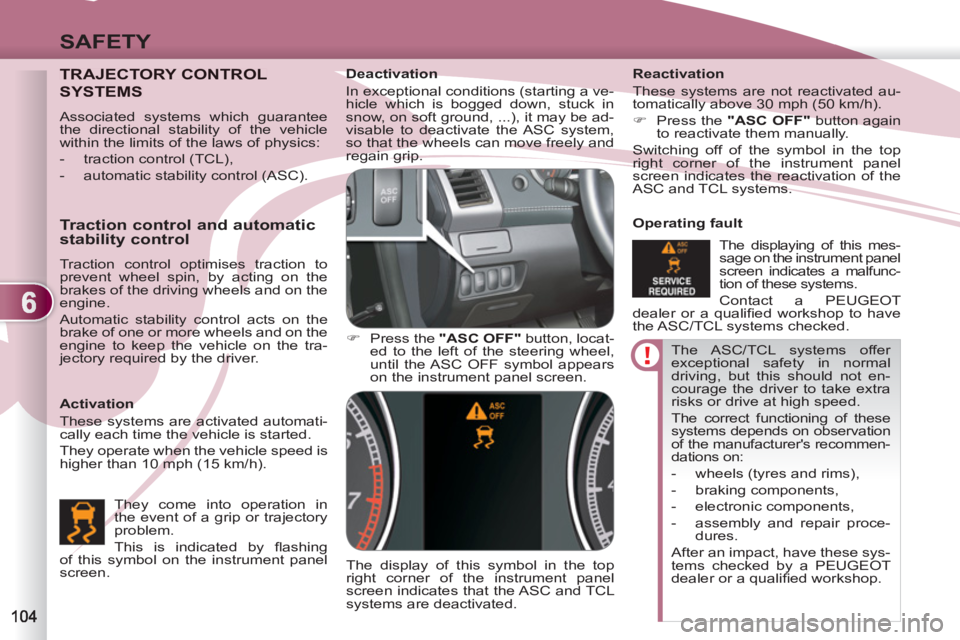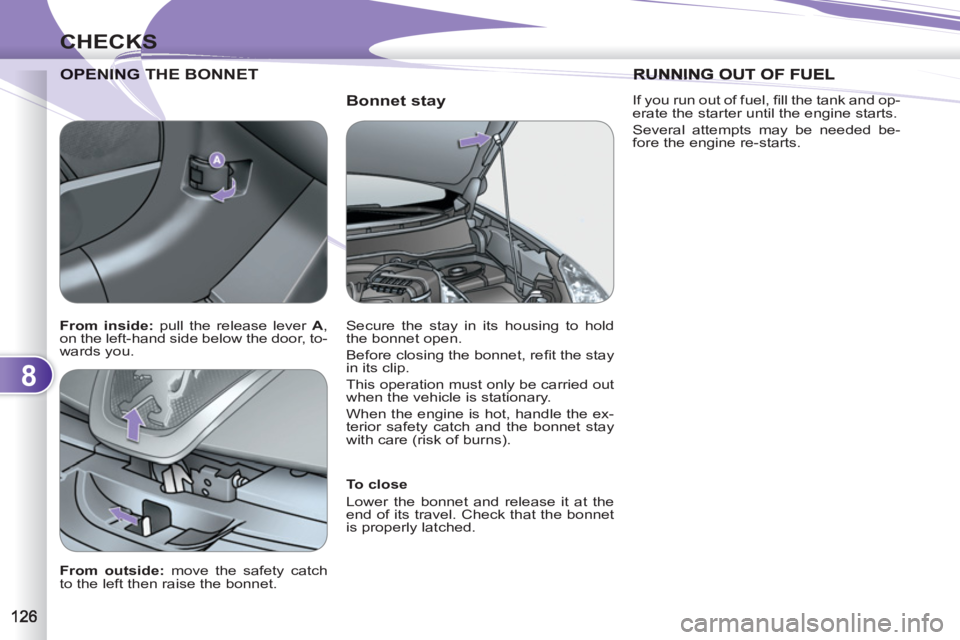2012 PEUGEOT 4007 check engine
[x] Cancel search: check enginePage 73 of 236

2
COMFORT
Stowing rings
There are four stowing rings in the boot
for securing luggage:
- two rings are located on the boot
fl oor,
- two rings are located on the rear
side pillars.
* On 5-seat version only. Raise the boot fl oor to gain access to
this compartment.
Right-hand side enclosed storage
compartment
This storage compartment contains the
tools for changing a wheel.
Storage compartment in the fl oor *
12 V socket (120 W max)
This operates when the ignition switch
is in the "ON" or "ACC" position.
Lift the cover to gain access to the
socket.
Check that the electrical equip-
ment operates on 12 V and that
its maximum electrical power is
120 W.
The prolonged use of electrical
equipment without running the
engine may discharge the bat-
tery.
Page 106 of 236

6
SAFETY
The ASC/TCL systems offer
exceptional safety in normal
driving, but this should not en-
courage the driver to take extra
risks or drive at high speed.
The correct functioning of these
systems depends on observation
of the manufacturer's recommen-
dations on:
- wheels (tyres and rims),
- braking components,
- electronic components,
- assembly and repair proce-
dures.
After an impact, have these sys-
tems checked by a PEUGEOT
dealer or a qualifi ed workshop.
Deactivation
In exceptional conditions (starting a ve-
hicle which is bogged down, stuck in
snow, on soft ground, ...), it may be ad-
visable to deactivate the ASC system,
so that the wheels can move freely and
regain grip.
�)
Press the "ASC OFF"
button, locat-
ed to the left of the steering wheel,
until the ASC OFF symbol appears
on the instrument panel screen.
The display of this symbol in the top
right corner of the instrument panel
screen indicates that the ASC and TCL
systems are deactivated.
Reactivation
These systems are not reactivated au-
tomatically above 30 mph (50 km/h).
�)
Press the "ASC OFF"
button again
to reactivate them manually.
Switching off of the symbol in the top
right corner of the instrument panel
screen indicates the reactivation of the
ASC and TCL systems.
Operating fault
The displaying of this mes-
sage on the instrument panel
screen indicates a malfunc-
tion of these systems.
Contact a PEUGEOT
dealer or a qualifi ed workshop to have
the ASC/TCL systems checked.
TRAJECTORY CONTROL
SYSTEMS
Activation
These systems are activated automati-
cally each time the vehicle is started.
They operate when the vehicle speed is
higher than 10 mph (15 km/h).
Traction control and automatic
stability control
Traction control optimises traction to
prevent wheel spin, by acting on the
brakes of the driving wheels and on the
engine.
Automatic stability control acts on the
brake of one or more wheels and on the
engine to keep the vehicle on the tra-
jectory required by the driver.
They come into operation in
the event of a grip or trajectory
problem.
This is indicated by fl ashing
of this symbol on the instrument panel
screen.
Associated systems which guarantee
the directional stability of the vehicle
within the limits of the laws of physics:
- traction control (TCL),
- automatic stability control (ASC).
Page 127 of 236

8
CHECKS
PARTNERS IN PERFORMANCE
AND PROTECTION OF
THE ENVIRONMENT
Innovation at the service
of performance
The TOTAL Research and Development
teams develop lubricants for PEUGEOT
which satisfy the requirements of the latest
technical innovations incorporated in
PEUGEOT vehicles.
This ensures that you obtain the best
performance and the maximum engine life.
Reduced exhaust emissions
TOTAL lubricants are formulated to
optimise the effi ciency of engines and
the protection of the emissions post-
treatment systems. It is crucial to observe
the servicing recommendations made by
PEUGEOT to ensure correct operation.
RECOMMENDS
Page 128 of 236

8
CHECKS
Bonnet stay
ENING THE BONNET
OPENING T
To close
Lower the bonnet and release it at the
end of its travel. Check that the bonnet
is properly latched.
From outside:
move the safety catch
to the left then raise the bonnet. Secure the stay in its housing to hold
the bonnet open.
Before closing the bonnet, refi t the stay
in its clip.
This operation must only be carried out
when the vehicle is stationary.
When the engine is hot, handle the ex-
terior safety catch and the bonnet stay
with care (risk of burns).
RUNNING
From inside:
pull the release lever A
,
on the left-hand side below the door, to-
wards you.
If you run out of fuel, fi ll the tank and op-
erate the starter until the engine starts.
Several attempts may be needed be-
fore the engine re-starts.
Page 129 of 236

8
CHECKS
PETROL ENGINE
1.
Screenwash and headlamp wash
reservoir.
2.
Coolant reservoir.
3.
Power steering fl uid reservoir.
4.
Brake fl uid reservoir.
5.
Fusebox.
6.
Battery.
7.
CVT gearbox dipstick.
8.
Radiator cap.
9.
Engine oil dipstick.
10.
Engine oil fi ller cap.
11 .
Air fi lter. Access for checking the levels of the various fl uids and the replacement of certain components.
Page 130 of 236

8
CHECKS
SEL ENGINEDIESEL EN
Access for checking the levels of the various fl uids and the replacement of certain components.
1.
Coolant reservoir.
2.
Power steering fl uid reservoir.
3.
Screenwash and headlamp wash
reservoir.
4.
Brake fl uid reservoir.
5.
Fusebox.
6.
Battery.
7.
Engine oil dipstick.
8.
Engine oil fi ller cap.
9.
Air fi lter.
Page 131 of 236

8
CHECKS
CHECKING LEVELS
Brake fluid level
To avoid any risk of scalding, unscrew
the cap by two turns to allow the pres-
sure to drop. When the pressure has
dropped, remove the cap and top up
the level.
Oil level
The reading will only be correct
if the vehicle is on level ground
and the engine has been off for
more than 15 minutes.
The check is carried out either
when the ignition is switched on using
the oil level indicator on the instrument
panel, or using the dipstick.
It is normal to top up the engine oil be-
tween services. The manufacturer recom-
mends that the oil level be checked, and
topped up if necessary, every 3 000 miles
(5 000 km). The brake fl uid level should be
between the "MAX" and "MIN"
marks.
If it is not, check the brake pad
wear.
Changing the brake fl uid
Refer to the servicing booklet for details
of the interval for this operation.
Coolant level
The coolant level must be mea-
sured when the engine is cold
and should be between the
"LOW" and "FULL" marks.
When the engine is warm, the
temperature of the coolant is regulated
by the fan. This can operate with the ig-
nition off.
On vehicles which are fi tted with a
particle emission fi lter, the fan may
operate after the vehicle has been
switched off, even if the engine is
cold.
In addition, as the cooling system is
pressurised, wait at least one hour after
switching off the engine before carrying
out any work.
Screenwash and headlamp
wash * fluid
Check the fl uid level regularly,
using the gauge.
*
According to country.
Changing the engine oil
Refer to the servicing booklet for details
of the interval for this operation.
In order to maintain the reliability of the
engine and emission control system,
the use of additives in the engine oil is
prohibited.
Oil specifi cation
The oil must correspond to your engine
and conform to the manufacturer's
recommendations.
Fluid specifi cation
The brake fl uid must conform to the
manufacturer's recommendations and
fulfi l the DOT4 standards.
Changing the coolant fl uid
Refer to the servicing booklet for details
of the interval for this operation.
Fluid specifi cation
The coolant must conform to the manu-
facturer's recommendations.
Fluid specifi cation
This fl uid must conform to the manufac-
turer's recommendations for optimum
cleaning.
Power steering fluid level
Check the fl uid level with the engine at
idle.
Check that the power steering fl uid
level is always between the "MAX" and
"MIN" marks and top up if necessary.
Fluid specifi cation
This fl uid must conform to the manufac-
turer's recommendations.
Check all of these levels regularly and
top them up if necessary, unless other-
wise indicated.
If a level drops signifi cantly, have the
corresponding system checked by a
PEUGEOT dealer or a qualifi ed work-
shop.
When working under the bonnet, take
care as certain areas of the engine may
be extremely hot (risk of burns).
Page 132 of 236

8
CHECKS
Diesel additive level (Diesel
with particle emission filter)
The minimum level of this additive is indicat-
ed by lighting of the service warning lamp,
accompanied by an audible signal and a
message on the multifunction screen.
Topping up
This additive must be topped up by a
PEUGEOT dealer or a qualifi ed work-
shop without delay.
Waste products
CHECKS
Battery
Check the electrolyte level
regularly. If necessary, top up
the level with distilled water.
Check that the terminals are
clean and correctly tightened,
particularly in summer and winter.
When carrying out work on the battery,
refer to the "Practical information" sec-
tion for details of the precautions to be
taken before disconnecting the battery
and following its reconnection.
Air filter and passenger compartment filter
Refer to the servicing booklet
for details of the replacement
intervals for these compo-
nents.
Depending on the environ-
ment (dusty atmosphere...) and the use
of the vehicle (city driving...), replace
them twice as often if necessary (refer
to the "Engines" paragraph).
A clogged passenger compartment fi l-
ter may have an adverse effect on the
performance of the air conditioning sys-
tem and generate undesirable odours.
Oil filter
Replace the oil fi lter each time
the engine oil is changed.
Refer to the servicing booklet
for details of the replacement
interval for this component.
Particle emission filter (Diesel)
Maintenance of the particle emission fi l-
ter must be carried out by a PEUGEOT
dealer or a qualifi ed workshop.
Following prolonged operation
of the vehicle at very low speed
or at idle, you may, exception-
ally, notice the emission of water
vapour at the exhaust on accel-
eration. This does not have any
adverse effect on the perfor-
mance of the vehicle or on the
environment.
Avoid any prolonged contact of
used oil or fl uids with the skin.
Most of these fl uids are harmful
to health or indeed very corro-
sive.
Do not discard used oil or fl uids into
sewers or onto the ground.
Empty used oil into the containers pro-
vided for this purpose at PEUGEOT
dealers (France) or a qualifi ed work-
shop, or take them to an authorised
waste disposal site.
Do not discard the oil fi lter through
public channels, deposit it in the
containers dedicated to this use in
the PEUGEOT network (France) or
a qualifi ed workshop or take them to
an authorised waste disposal site.
Unless otherwise indicated, check
these components in accordance with
the servicing booklet and in relation to
your engine.
Otherwise, have them checked by a
PEUGEOT dealer or a qualifi ed work-
shop.